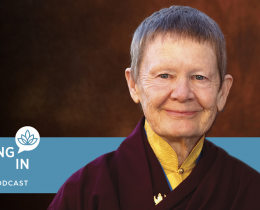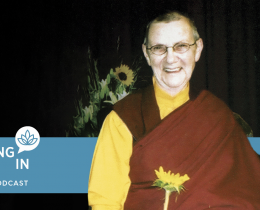In the Buddhist tradition, there are three stages on the path of practice: Listening, Reflection, and Practice. The first stage, listening came from the historical setting of the Buddha’s time, when there was no radio, DVDs, or the Internet. The monks and nuns listened intently to the Buddha’s teachings, called dharma talks. The monastics who were listening were referred to as sravajas, which meant “listeners or hearers” of the Buddha’s teachings. Having listened, they reflected further, and they then practiced the teachings.
We don’t receive input only through listening. In modern times, our six sense organs are constantly bombarded by stimuli. Our eyes receive images from watching movies and TV, or seeing advertisements and reading magazines. Our ears absorb sounds from listening to the radio, music, and conversations. Our nose is bombarded by fragrances. Our tongue is exposed to food, with nutrients as well as toxins. Our body experiences touch and other tactile sensations.
Finally, our mind or consciousness has the capacity of being aware of the other five senses as they receive input from the environment. Our mind itself also perceives, reflects, and generates thoughts.
Through these six sense organs, we receive so much input, and this makes up the underlying currents in our consciousness, like the currents deep below the surface of the ocean. Day and night, moment to moment, sensory inputs come in. The practice is to become more aware of the initial inputs and the ongoing inputs.
If we can be aware at the moment a stimulus is in contact with our senses—the moment we see something on the road, hear the phone ringing, or see someone doing something—we may breathe calmly and perceptions may not always form. Even if the body experiences “excitement” or “agitation,” our mindfulness practice of breathing can help maintain a calm breathing pattern or slow its rate down.
We can ask ourselves: “What is it that I am taking into my body and consciousness? What is it that I have perceived? How am I reacting to this situation?”
Or we can simply recognize: “My body is tensing up right now. I don’t know why, but I feel choked. I cannot breathe. My voice seems to change to a higher pitch.”
Those are the bodily signs that help us to call a feeling by its true name or to be aware: “There is a feeling here,” or simply, “There is something going on here.” This alone is already wakefulness. This is what we call “mindfulness.”
Our sensory perceptions are like a trail. When we pass by once, a faint line is laid down. It can become overgrown if we don’t ever use it again. However, if we travel it often, it will become a trail, a road, a street, and then a freeway. When we experience an emotion again and again, it becomes habitual and habituated. When the neural pathway is well established, it takes only a single sight or sound for us to immediately have a perception of danger, hatred, or irritation. We immediately have a psychological response. Perhaps it’s not a snake in the road, it’s only a piece of rope. Yet we go through this whole ordeal because it is habit.
Our feelings about other people follow the same pathways. When we dislike or are irritated by someone, just the sight or sound of that person can trigger a stress response in us. Our own feelings become toxic to us. The other person may not even be aware of what’s going on. Yet chemicals released into our blood steam can bring about a stress response in our own body. It’s written again and again into our long-term memory.
In this way, a small dislike can become hatred or another strong emotion. We may think about that person day and night. This object of our mind may be someone with whom we’re infatuated or someone we dislike.
Over time, our suffering can be rehearsed, strengthened, and ingrained in us. Many of us think that we thrive on waves of passion and excitement. When the wave comes, it crashes and we crash with it. We become the wave. We are the wave. We think that without these waves peaking and crashing, we’d be bored.
We defend that anger; we say it gives us energy. I used to believe that depression was necessary to write great poetry! We claim this because we know nothing better than the waves. All our life, we go through one wave after another, and we believe that only the waves exist.
But, below the waves, there’s an immense ocean that we might never have explored. Above the wave, there’s infinite space. Some moments, as we sit quietly, listening to our breathing or smiling at a flower, we may touch spaciousness—what it means to not bob up and down, to not lunge and crash again and again; what it means to be stable and still.
Of course, we don’t cease having perceptions and feelings. They can be there, but we don’t have to become them. We can recognize them, while we are the ground and not the wave.



